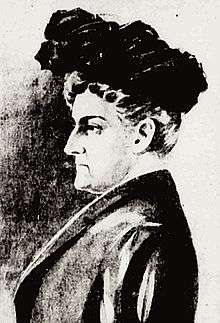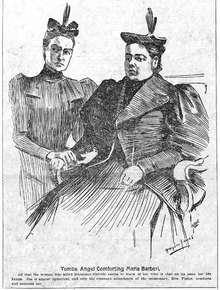Rebecca Salome Foster
| Rebecca Salome Foster | |
|---|---|
 | |
| Born |
October 24, 1848 Alabama |
| Died |
February 22, 1902 (aged 53) New York City (Park Avenue Hotel fire) |
| Nationality | American |
| Occupation | Christian missionary |
| Known for | prison relief worker "The Tombs Angel" |
Rebecca Salome Elliott Foster (October 24, 1848 - February 22, 1902)[1] was a missionary/prison relief worker known as the "Tombs Angel"[2][3] because she attended to criminals incarcerated at The New York Halls of Justice and House of Detention (otherwise known as "The Tombs").
Biography
Rebecca Salome Elliott was born 24 October 1848 in Alabama, the daughter of John Howard Elliott and Margaret Adele Blue. She married Union Civil War General John Armstrong Foster on February 28th, 1865. US President Abraham Lincoln attended their wedding since Foster was a member of the presidential cabinet.[4] The Fosters had four children: Salome (Lomie) Elliott (1865), Marie Louise (1867), Jeanette Jennie (1873), and John (Johnnie) Armstong (1873). Rebecca's husband John Foster was a prominent lawyer and Republican politician in New York but eventually succumbed to alcoholism, abandoning his family two years before he died in 1890.[5] Rebecca supported herself and her family from the remuneration received as a city missionary. From the time of her abandonment on she wore black mourning clothes in public.[6] Rebecca Salome Foster was one of at least 14 people who died in the Park Avenue Hotel fire on February 22, 1902. Her role as the somewhat anonymous "Tombs Angel" came to the forefront in the media after her death and her February 25, 1902 funeral at the Calvary Church in Manhattan was heavily attended by people she had saved from conviction, notable reform figures, and officials and court judges.[7][8]
"Tombs Angel"

From the mid-1880s on Rebecca Salome Foster worked assisting people who were defendants in the New York legal system. She became known as a "Tombs Angel" because she attended to criminals incarcerated at The New York Halls of Justice and House of Detention ("The Tombs"). She was one of two people who became notable in the roll, the other being Ernestine Schaffner who also worked on behalf of prisoners from about 1870 til her death 1903.[9] Foster started working with the Presbyterian City Mission Society helping with petty crime cases but eventually worked on her own in the "Tombs". Besides administering to the needs of the incarcerated, the trust she developed with government officials put her in the role of unofficial court investigator and advisor, trying to ascertain the facts of each inmate's case and giving her recommendation as to whether the person was innocent or guilty.[10][11] She also worked with defendants after they were released giving her the role of an ad hoc "probation officer" before that formal system existed in New York.[12]
References
- ↑ findagrave.com - Rebecca Salome Elliott Foster
- ↑ Herbert Mitgang, The Man Who Rode the Tiger: The Life and Times of Judge Samuel Seabury, Fordham Univ Press - 1996, page 36
- ↑ DOUGLAS C. McGILL, Uncovering New York City's Art Collection, New York Times, Published: September 24, 1987
- ↑ New York Times February 23, 1902, page 2
- ↑ New York Times February 23, 1902, page 2
- ↑ New York Times February 23, 1902, page 2
- ↑ Death of Mrs Foster the Tombs Angel, The Churchman, Volume 85, Churchman Company - 1902, page 285
- ↑ James Renwick Jr's 1848 Calvary Episcopal Church - Daytonian in Manhattan
- ↑ John Josiah Munro, The New York Tombs, Inside and Out!: Scenes and Reminiscences Coming Down to the Present.--A Story Stranger Than Fiction, with an Historic Account of America's Most Famous Prison, 1909, pages 248-249
- ↑ Herbert Mitgang, The Man Who Rode the Tiger: The Life and Times of Judge Samuel Seabury, Fordham Univ Press - 1996, page 36
- ↑ Arthur Henry, The Tombs Angel, The Outlook, Volume 72, Outlook Company - 1902, pages 163 - 165
- ↑ Herbert Mitgang, The Man Who Rode the Tiger: The Life and Times of Judge Samuel Seabury, Fordham Univ Press - 1996, page 36